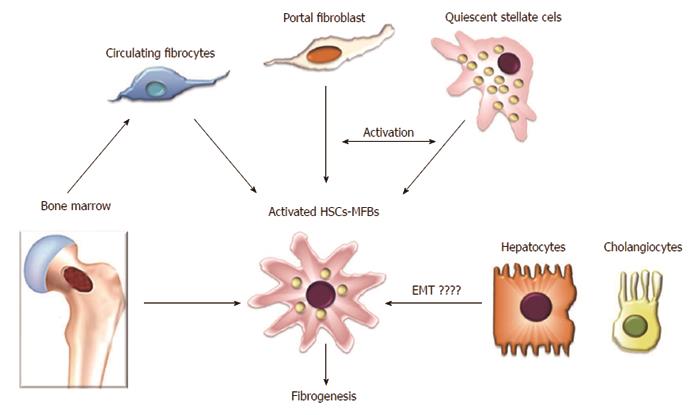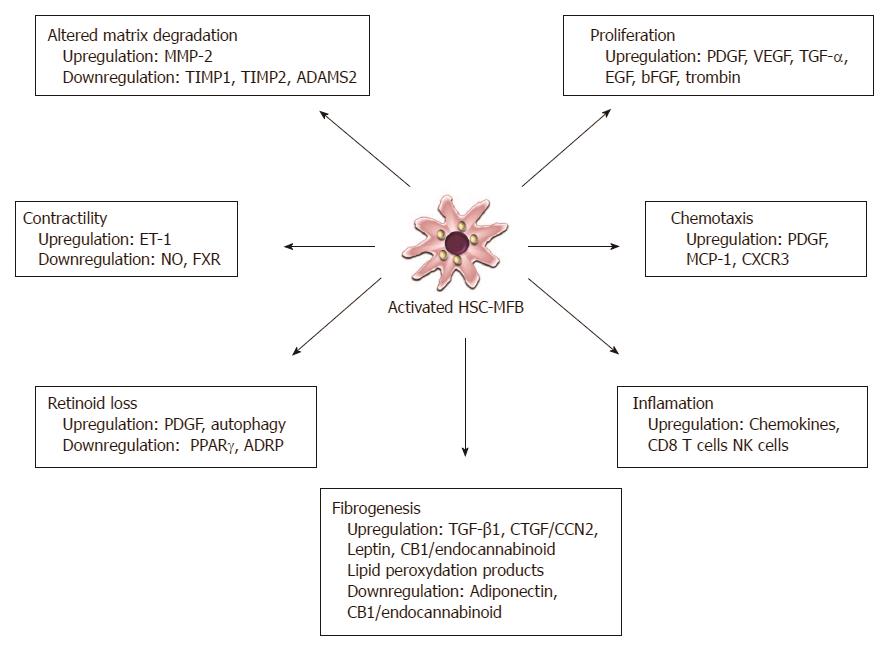Copyright
©2014 Baishideng Publishing Group Inc.
World J Gastroenterol. Jun 21, 2014; 20(23): 7260-7276
Published online Jun 21, 2014. doi: 10.3748/wjg.v20.i23.7260
Published online Jun 21, 2014. doi: 10.3748/wjg.v20.i23.7260
Figure 1 Extracellular matrix accumulation in subendothelial space activates quiescent hepatic stellate cells leading to the loss of hepatocyte microvilli and disappearance of endothelial fenestrations.
These architectural changes impair transport of solutes from the sinusoid to the hepatocytes, further contributing to the hepatocyte damage. ECM: Extracellular matrix; HSCs: Hepatic stellate cells.
Figure 2 Hepatic myofibroblasts are a heterogenous population of fibrogenic cells.
Hepatic stellate cells are considered to be a major source of liver fibrogenic cells followed by portal fibroblasts that play an important role in the fibrogenic process during cholestatic liver diseases. Other sources of hepatic myofibroblasts include circulating fibrocytes and bone marrow-derived cells that constitute a minor proportion of liver fibrogenic cells. The epithelial origin of liver fibrogenic cells is unlikely. EMT: Epithelial mesenchymal transition; MFBs: Myofibroblasts; HSCs: Hepatic stellate cells.
Figure 3 Hepatic myofibroblasts myofibroblasts have multiple functions during liver fibrogenesis.
In the activated form, hepatic stellate cells show de novo properties, including increased proliferation, fibrogenesis, contractility, chemotaxis, matrix degradation, retinoid loss and secretion of chemokines. Each of these properties is controlled by the release of many cytokines acting in an autocrine and paracrine manner offering many potential sites for therapeutic intervention. MMP: Matrix metalloproteinase; TIMP: Tissue inhibitor of matrix metalloproteinase; ADAMS2: A disintegrin and metalloproteinase 2; PDGF: Platelet derived growth factor; VEGF: Vascular endothelial growth factor; TGF-α: Transforming growth factor-α; EGF: Epidermal growth factor; bFGF: Basic fibroblast growth factor; TGF-β1: Transforming growth factor-β1; CTGF/CCN2: Connective tissue growth factor; ET-1: Endothelin 1; NO: Nitric oxide; FXR: Farnesoid X receptor; PPARγ: Peroxisome proliferators activated nuclear receptorsγ; ADRP: Adipose differentiation related protein.
- Citation: Elpek G&. Cellular and molecular mechanisms in the pathogenesis of liver fibrosis: An update. World J Gastroenterol 2014; 20(23): 7260-7276
- URL: https://www.wjgnet.com/1007-9327/full/v20/i23/7260.htm
- DOI: https://dx.doi.org/10.3748/wjg.v20.i23.7260











